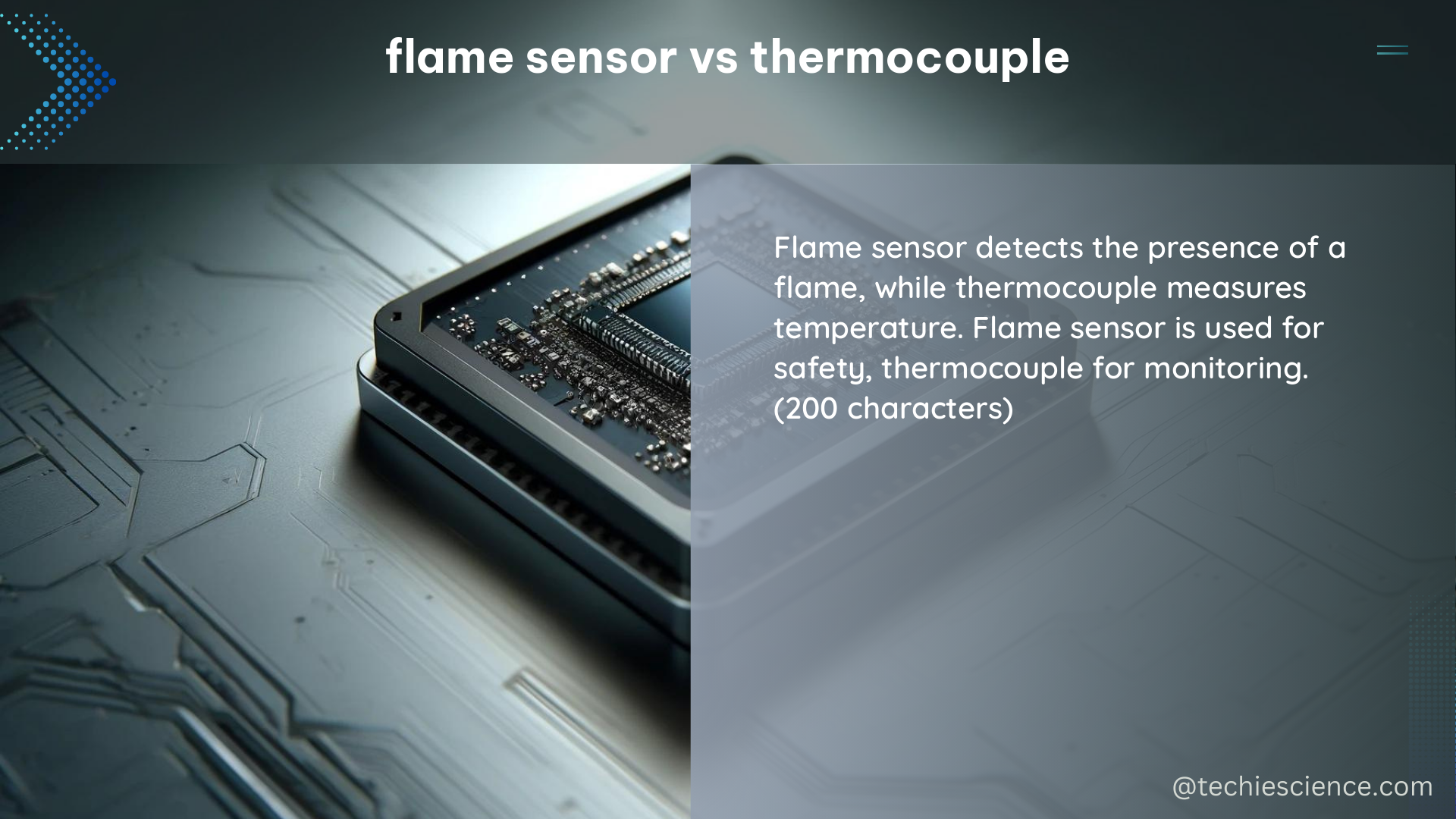Flame sensors and thermocouples are two distinct types of sensors used for different purposes. While flame sensors are designed to detect the presence of a flame, thermocouples are employed to measure temperature. This comprehensive guide will delve into the technical specifications, applications, and DIY project considerations for both flame sensors and thermocouples, providing you with a thorough understanding of these essential components.
Understanding Flame Sensors
Flame sensors are devices that detect the presence of a flame by sensing the light emitted by the combustion process. These sensors are commonly used in gas-powered appliances, such as furnaces, water heaters, and ovens, to ensure the safe operation of the equipment.
Technical Specifications of Flame Sensors
- Temperature Range: Flame sensors are typically rated for a temperature range of -40°C to 125°C (-40°F to 257°F).
- Response Time: The response time of flame sensors can vary depending on the material used. Ceramic flame sensors can have a response time of less than 1 millisecond, while metal flame sensors may have a response time of several milliseconds.
- Output Signal: Flame sensors can provide either a voltage or current output signal, which indicates the presence or absence of a flame.
- Materials: Flame sensors can be manufactured using a variety of materials, including ceramics, metals, and semiconductors.
Flame Sensor Applications
Flame sensors are essential in the following applications:
- Gas Appliances: Flame sensors are used in gas-powered appliances, such as furnaces, water heaters, and ovens, to detect the presence of a flame and ensure safe operation.
- Boilers and Burners: Flame sensors are employed in industrial boilers and burners to monitor the combustion process and prevent unsafe conditions.
- Fireplaces and Stoves: Flame sensors can be used in fireplaces and wood-burning stoves to detect the presence of a flame and prevent the release of unburned fuel.
- Aerospace and Automotive: Flame sensors are used in the aerospace and automotive industries to monitor engine and exhaust systems for the presence of flames or combustion.
Understanding Thermocouples

Thermocouples are temperature-sensing devices that work by measuring the temperature difference between two dissimilar metals. They are widely used in industrial applications, such as power plants, chemical processing facilities, and manufacturing processes, to monitor and control temperature.
Technical Specifications of Thermocouples
- Temperature Range: Thermocouples can be designed to measure temperatures ranging from -200°C to 2000°C (-328°F to 3632°F), depending on the specific materials used.
- Output Signal: Thermocouples provide a voltage output that is proportional to the temperature difference between the two metals.
- Materials: Common thermocouple materials include chromel-alumel (Type K), iron-constantan (Type J), and copper-constantan (Type T).
- Calibration: Thermocouples are typically calibrated to provide a specific output voltage per degree of temperature change. For example, a chromel-alumel (Type K) thermocouple has a calibration of approximately 40 microvolts per degree Celsius.
Thermocouple Applications
Thermocouples are used in a wide range of applications, including:
- Industrial Processes: Thermocouples are used in power plants, chemical processing facilities, and manufacturing processes to monitor and control temperature.
- Furnaces and Ovens: Thermocouples are used in furnaces, ovens, and other high-temperature equipment to ensure proper temperature control and safety.
- Automotive and Aerospace: Thermocouples are used in the automotive and aerospace industries to monitor engine and exhaust temperatures, as well as other critical components.
- Research and Development: Thermocouples are used in research and development applications, such as materials testing and scientific experiments, to accurately measure temperature.
DIY Projects with Flame Sensors and Thermocouples
Building a DIY project with flame sensors or thermocouples can be a rewarding and educational experience. Here are some considerations for each type of sensor:
Flame Sensor DIY Projects
To build a flame sensor circuit, you will need the following components:
– Flame sensor
– Microcontroller (e.g., Arduino)
– Resistors and capacitors
– Wiring and breadboard
You will also need to write software to read the output of the flame sensor and display the results on a computer or other device.
Thermocouple DIY Projects
To build a thermocouple circuit, you will need the following components:
– Thermocouple
– Multimeter or voltage measurement device
– Resistors, amplifiers, and other electronics components
– Wiring and breadboard
You will also need to calibrate the thermocouple by measuring its output voltage at known temperatures to ensure accurate temperature readings.
Conclusion
Flame sensors and thermocouples are essential components in a wide range of applications, from gas-powered appliances to industrial processes. By understanding the technical specifications, applications, and DIY project considerations for these sensors, you can unlock a world of possibilities for your own projects and experiments.
References:
- 40 CFR Part 63 Subpart A — General Provisions – eCFR
- ENERGY SAVINGS TOOLBOX – An Energy Audit Manual and Tool
- FIREMON: Fire effects monitoring and inventory system
- Recommended Practices for Measurement of Gas Path Pressures and Temperatures for Performance Assessment of Industrial Gas Turbines
- Sensors for daily life: A review – ScienceDirect.com

The lambdageeks.com Core SME Team is a group of experienced subject matter experts from diverse scientific and technical fields including Physics, Chemistry, Technology,Electronics & Electrical Engineering, Automotive, Mechanical Engineering. Our team collaborates to create high-quality, well-researched articles on a wide range of science and technology topics for the lambdageeks.com website.
All Our Senior SME are having more than 7 Years of experience in the respective fields . They are either Working Industry Professionals or assocaited With different Universities. Refer Our Authors Page to get to know About our Core SMEs.